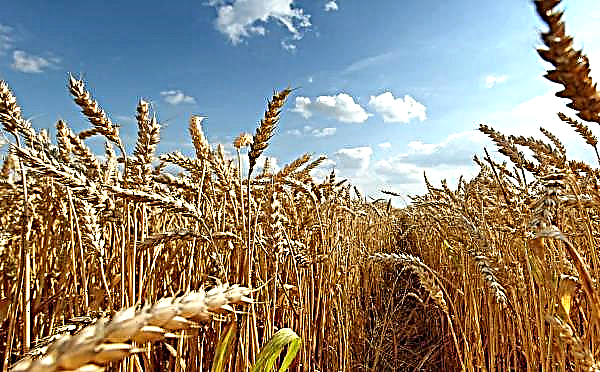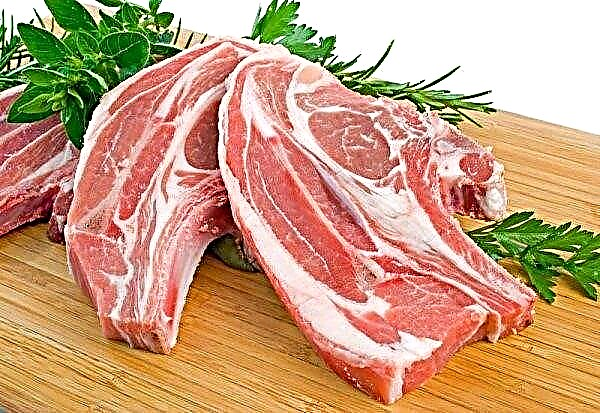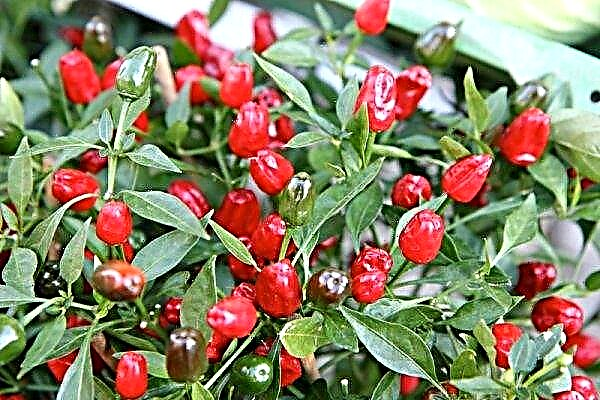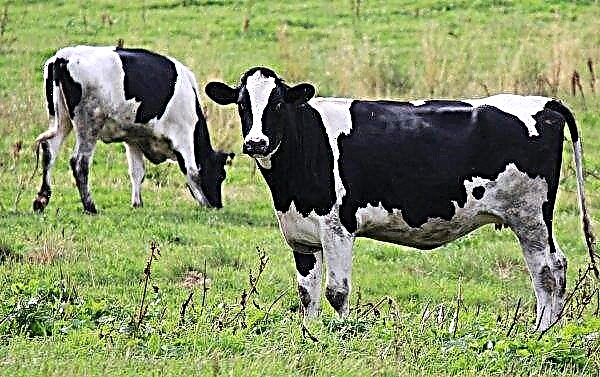In the gardens and parks can be grown different varieties of pines. In the world there are many of their species and varieties. Bunge pine is of interest due to its unusual trunk color, which turns gray over time. In the natural environment, the tree grows in northwestern China, and is also grown in gardens around the world. Our article will allow you to become more familiar with the Bunge pine and its cultivation.
Botanical tree description
Pine Bunge, or lacy pine (in Latin - Pinus bungeana), belongs to the Pine family. It grows slowly and eventually reaches a height of 25-30 m, and in the cross section its trunk may have a diameter of about 1 m. The bark has a smooth structure and is painted in gray-green color. Over time, exfoliating flakes give it a gray-white color with reddish spots.
The needles are connected in small bundles of three. They have a length of 9–15 cm, and in cross section reach 0.6–2 mm. The needles, hard to the touch, are painted in dark green color. Brown egg-shaped cones are covered with resin and located on branches in a single order or in two. They have a length of 5–6 cm, a width of 4–5 cm, with spines curved backward at the shields.
This coniferous tree has good frost resistance and can tolerate frosts down to -27 ° C. It should be borne in mind that the plant may suffer from a snowbreaker and ice load. This can break off the branches of a tree. That is why it is recommended to land it in the southern regions of the Russian Federation.

Origin of name
Pine got its name thanks to the botanist Alexander Bunge. This is a German-Russian professor-botanist, a member of the Academy of Sciences of St. Petersburg in Tsarist Russia. He discovered in 1831 this species of pine in China. In 1830, Bunge visited Beijing as part of a group with a spiritual mission from the Academy of Sciences. During his stay, he collected a lot of material and wrote scientific papers on it.
Did you know? In honor of Alexander Bunge, a crater on Mars is even named.
Landing
Bunge pine grows better in a well-lit area that is protected from gusts of wind. The fact is that tree trunks and branches can damage hurricane winds, as they have a somewhat fragile structure. This plant crop is undemanding to soils, but saline soil should be avoided. This tree feels good on slightly acidic, neutral and slightly alkaline light soils.
For planting, you should purchase a quality seedling. For this purpose, it is better to contact the nursery for growing this crop or a garden store. It is better to choose planting material 3-5 years old.

Landing is recommended to be carried out in April or at the end of August so that the seedling has time to adapt in a new place.
Important! Planting of pine is always carried out by the method of transshipment (with a lump of earth on the roots). The root neck when planting should be placed at ground level.
The landing process itself is as follows:
- Initially, a foundation pit is dug with a depth of 0.9–1 m and a width of 0.7–0.8 m.
- A drainage layer 20 cm high of crushed stone or gravel is placed at the bottom of the pit. You can also use broken brick for this purpose.
- Prepare a nutritious soil mixture. For this, turf ground, sand, earth from coniferous forest are mixed in equal parts, 30 g of nitrogen-containing fertilizers are added.
- The seedling is removed from the tank and placed in a prepared hole.
- Gently fall asleep a tree, ram the ground and well watered.

Pine seedlings can also be grown from seeds. So the plant will be more resistant to the local climateat. For this, the seeds are stratified for about a month in the refrigerator. Then they are kept in hot water for a day, and then soaked for 2 hours in a growth stimulator.
Sowing is carried out in nutritious loose soil to a depth of 7 mm and moistened from the spray gun. From above, the container is covered with a film and placed in a lit place with temperature indicators +18 ... + 22 ° С.
Periodically, the film is removed for ventilation. Germination can last 3–8 weeks. Landing in the open ground is made as early as next year. If the climate of the region is not suitable for this tree, then bonsai can be grown from its seeds.
Pine care
Young plantings of Bunge pine need special care. They are less frost-resistant than adults, sensitive to lack of moisture, diseases and pest attacks. An adult tree requires less attention, but it should not be left without care.
Watering and feeding
In the first year after planting, the seedling should be well watered. In this case, it must be ensured that there is no excessive moisture or stagnation of water. In subsequent years, the plant should be moderately moistened. For fertilizing, you can use special fertilizers for conifers or organic mixtures. Organics and fertilizers with a predominance of nitrogen are applied only in spring or summer, but not in autumn.

Loosening and mulching
Pine Bunge loves loose, well-permeable soil, therefore, after watering or rains, it is recommended to loosen the trunk circle, while removing weed grass. It is especially important to do this for young immature plants. Before winter, a shallow digging should be done around the plant, because pests like to winter in this place.
Since this pine tree loves moist soil, it is recommended to sprinkle the soil with peat, humus, needles or pine bark. This will serve as an obstacle to moisture evaporation, weed growth and the appearance of fungal diseases.
Important! In winter, the ground under a pine tree should be covered with a thick layer of mulch to protect the roots from freezing. Young plants are also recommended to wrap the airprotClipped fabric.
Pruning
Pine Bunge does not need to be formed. This tree can be cut only for sanitary purposes, removing diseased, broken and dry branches. If there is a desire to limit the growth of the crown, then only the growth of this year is removed. It is recommended not to cut, but to break out. If you want to cut off the interfering branch as a whole, then the place of the cut must be covered with garden varnish in order to avoid the penetration of infection through the cut.
The use of wood in landscape design
Pine Bunge fell in love with landscape designers for its metallic gray bark and evergreen needles. It is good for growing in parks and gardens. It can be found in botanical gardens in different countries of the world, including the Nikitsky Botanical Garden in Crimea. It often grows in several trunks.

The gray color of the trunk and the dark green needles create an interesting contrast. Exfoliating blades on the trunk create a scaly effect. The tree looks very decorative in a single landing and creates a spectacular accent and a pleasant shadow. It can be planted in groups and in compositions with other coniferous representatives.
It is good to plant Bunge pine in large gardens in an oriental style, near buildings. In China, it was often planted next to palaces and temples. This tree will look good next to large stones or against a European lawn.
Did you know? In eastern countries such as China and Japan, pine is a symbol of resilience and longevity. In European countries, this tree, like spruce, is associated with Christmas and New Year holidays.
Pine Bunge stands out from other members of the Pine family with its light gray trunk. This gives her a somewhat unusual look. If this representative of conifers organize proper care, then you will be able to admire its original appearance for many years.












